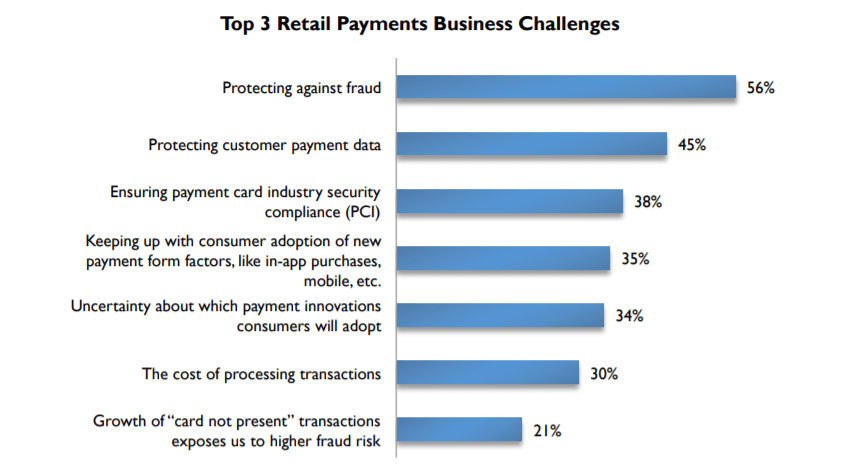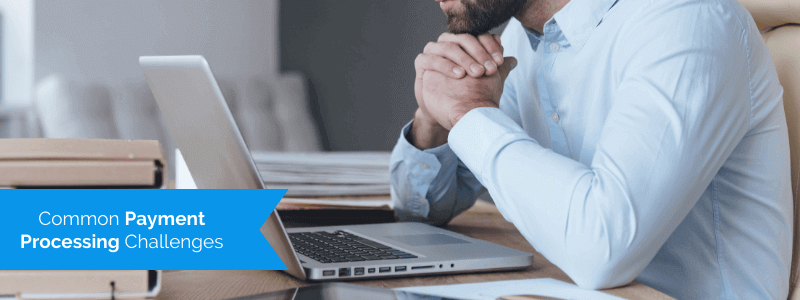Business owners wear many hats, and small business owners even more so. If you head a small company, chances are you’re overseeing sales, marketing, technology, and other day-to-day operations all by yourself.
Thankfully, some of these areas are straightforward. The other, more complex ones, such as payment processing, can present a challenge. Still, you don’t have to hire a new employee to handle payments as long as you think your strategy through in advance.
In this article, we’ll go over five payment processing challenges that small businesses face, and point you in the right direction so that you can effectively handle them.
So let’s see how you can improve the payment process for yourself and your customers.
Jump to section:
Ensuring Data Security
Providing Multi-Channel Payments
Preventing Integration Issues
Creating a User-Friendly Checkout Experience
Finding a Reliable Payment Processing Vendor

Don’t Limit Your Customer Pool!
Offer Multiple Payment Options Seamlessly
Ensuring Data Security
The most effective way to protect your business and clients from fraud is by ensuring data and payment security.
Since small businesses usually don’t have much control over how their data is processed, you should select a reputable, secure payment processing solution.
Running a business means facing various challenges every day. When it comes to payment processing, business owners identify the top challenges as defending their companies from fraud and protecting customer payment data.

Source: RSR Research
Data protection and fraud awareness are so prioritized because of the consequences that stem from ignoring payment security.
One family-owned business, a Maine-based construction company called Patco Construction, learned of the detrimental effects of neglecting payment security the hard way. The company lost more than half a million dollars in a cyberattack.
Attackers used a Trojan virus to get the company’s online banking credentials and then stole $588,000 in fraudulent ACH transfers.
Patco managed to recover some money, but they were still left with a significant loss. In the following years, Patco sued the bank, blaming the loss on the bank’s reliance on password and secret questions systems rather than using multifactor authentication.
Therefore, on top of the money lost to the cyberattack, the company had to pay interest and legal fees.
If you’re not big on anecdotes, let’s see what numbers say.
A 2021 survey on cyberattacks found that almost half of small businesses hit by attacks have spent between $250,000 and $500,000 to cover the costs of breaches, and some had to pay up to $1M.
Source: Regpack
Since you can’t fend off the attackers yourself, you should invest a lot of research in the selection of your payment solution. Every detail matters, from how you handle credit card information, to the security protocols your solution has in place.
For instance, if you want to ensure that credit card payments are processed securely, your payment vendor has to be PCI compliant. Before you close the deal, don’t forget to ask for proof of compliance with security standards.
It would be a mistake to think that cyberattacks are always complex schemes. Sometimes, the only thing the attackers need is your card number.
Volunteer Voyages, a single-owner small business from the US, lost $14,000 in fraudulent charges when an attacker stole the owner’s card information.
The owner notified the bank, but they were never reimbursed. This story goes to show that you can’t always count on the bank to restore your money, so it’s best to always stay prepared.
Just like you wouldn’t move into a house without a lock on the front door, you shouldn’t start a business without getting a solid data security solution to protect your payments.
Providing Multi-Channel Payments
A challenge many business owners struggle with is what payment options to offer. If you want your customers to have options but don’t want to manage and pay multiple vendors, your business may benefit from a multi-channel payment system.
One of the strategies for small businesses to stay competitive is recognizing customer payment preferences and implementing them.
Some of the popular payment methods in the United States are:
- Credit and debit cards
- Mobile wallets
- Recurring payments
- Cash
- ACH transactions
- eChecks
If you were to hire a separate payment processor for each of these methods, you’d quickly find yourself spending more time on accounting and finance management than on running your business.
Luckily, multi-channel payment solutions can save you the trouble.
A good payment solution allows your customers to pay in-store or online, on your webshop, all with different payment instruments.
Some even offer mobile POS devices so that those who deliver services in various locations can effortlessly collect payments.
An example of a small business that successfully adapted to the changing market is Love Iguehi, a Californian apparel company. When the pandemic hit in 2020, the owner joined the Keep Oakland Alive program and had a webshop made.
She now accepts different credit and debit cards, as well as payments made via Google Pay, Apple Pay, and Venmo.
Offering a variety of payment options is more than a nice-to-have quality; the modern customers expect it.
A 2021 Podium survey has shown that the convenience of payment options is the second most important factor when supporting a local business—customers care about it more than about refunds, discounts, or coupons.
The survey has also shown that nearly a quarter of customers abandon transactions if their preferred payment method isn’t available.
Source: Regpack
A multi-channel payment solution will also help you handle in-store transactions. Cash use may be on the decline, but it’s still present, so why limit yourself to electronic payments if your vendor also allows you to process cash?
Selling to customers from other countries is also a challenge for small businesses.
Opening different bank accounts in each foreign currency you want to accept is a complicated and costly process.
Instead, you can accept payments in different currencies via your multi-channel payment provider. Our payment processing software, Regpack, lets you collect credit card payments in any currency you wish without having to handle bank accounts across the globe.
All in all, multi-channel payment options give you flexibility —which is of vital importance to modern customers.
Decrease Non-Payment By 75%
With Flexible Payment Plans!
Preventing Integration Issues
Keeping track of payments is difficult if your financial records are all over the place. Fortunately, integrated payment software can help you arrange all information on received payments.
Bookkeeping used to be a lot more complicated before electronic and online payments. All transactions had to be recorded in journals or, later, spreadsheets. Organizing and finding all the resulting documentation was just as time-consuming.
Today, the process is much simpler, especially with payment solutions that automatically catalog each transaction into a database.
Once you have a clear overview of your transactions, you can easily generate reports to see how your business is doing.
Similarly, with well-organized payment data, you can find details on all payments in a matter of minutes.
Source: Regpack
When you automate the collection of payment data, you eliminate the need for human data error that regularly results in inaccurate records.
You can reap even more benefits if you synchronize your payment solution with an accounting system.
Direct communication between the two helps you reduce:
- Data loss
- Time and money spent on accounting
- Duplicated documents
- Labor costs
Choosing a payment processor can be a challenge when you’re first starting out. To narrow the selection down, one of your criteria should be the ease of integration.
Unfortunately, almost 90% of companies claim that poor integration hinders their digitalization efforts. Still, if you devote time to finding a payment solution that you can easily synchronize with the other software you use, you’ll be able to save money in the long run.
In addition to how it combines with other pieces of software, you should also pay attention to how conveniently you can integrate your selected payment solution into your website.
The quality of the integration is visible to your customers, so make sure the payment process is functional and looks great, which brings us to our next payment processing challenge: checkout.
Creating a User-Friendly Checkout Experience
Building a webshop from scratch seems like a piece of cake until you come to the part where you have to implement payments.
You can overcome this challenge by hiring professionals who can ensure a secure and user-friendly checkout so your customers can have a carefree shopping experience.
Even if you’re already aware that customers want convenience in shopping, you may still be underestimating how important it is.
According to the National Retail Federation, 97% of customers have backed out of a purchase because it wasn’t convenient enough.
Since you don’t want to give your customers any reason to abandon their carts, you should know that checkout simplicity plays a significant role in whether customers complete or abandon a purchase.
So, what makes a good checkout experience?
Let’s take a look at eBay, an eCommerce website often praised for being easy to use.
Source: eBay
As you can see, customers can choose the model, color, and quantity of a product with a single click. Next, the bold blue color clearly indicates where they have to click to start the purchase.
Remember when we said that the variety of payment options matters? eBay is very well aware of that, so the company shows all payment methods they accept even before you initiate the purchase.
Once the customers click on the Buy it Now button, they are redirected to the single checkout page, where they enter billing and shipping information. It’s as simple as that.
Here’s another example of a checkout found at Boots, the pre-eminent British health and pharmacy retailer.
Source: Boots
In this photo, the checkout looks fine.
However, the problem is that after selecting their products, customers are redirected through seven different pages just to get to the first step of the actual purchase, the one you see in the photo.
It takes several more redirects to enter payment information and finally complete the purchase.
Such a lengthy process is bound to deter customers from finalizing the process; they can always find similar products or services on webshops where they don’t have to jump through hoops just to give the vendor their money.
If you create a checkout process similar to the one used by Boots, you’re risking customers giving up halfway through.
But if you take eBay as a role model and make your checkout process user-friendly and simple, your payment process will be seamless. The fewer redirects, the better.
If you’d like to know more about this topic, read our post with more tips on improving your customers’ payment experience.
Finding a Reliable Payment Processing Vendor
Since you can’t process payments without a vendor, make sure to find an affordable and reliable one. You have to be able to count on them to help you if any issues arise.
Let’s clear up the first challenge that springs to mind when deciding on the vendor; the price.
It usually depends on the number of transactions you make or their value. Some vendors charge a percentage of each transaction, while others have a flat rate.
The price also varies based on the specific needs of your business. For instance, if your business is mobile, you’ll have to pay additional fees for a portable POS device.
Keep in mind that the seemingly cheapest option won’t necessarily be the most affordable one in the long run.
Sometimes, vendors don’t disclose all their fees right away, or if they do, they shroud them in jargon. This is why you should insist on a definite, comprehensible list.
Of course, the price is only one of the factors you should consider. Don’t forget to research how your vendor can assist you in case of a complication.
Online resources and tutorials are a plus, but live customer support is even more vital. Ideally, your vendor will have an in-house team to resolve any problems, rather than outsourcing support.
When an issue occurs, you want a reliable vendor who will respond right away so that you can continue with your operations as soon as possible.
To help you find the most suitable vendor for your business, we’ve compiled a list of questions you can ask to check their compatibility with your needs.
- Does the vendor support foreign currencies?
- What kind of customer support does the vendor have?
- Can the vendor support your growth?
- What fees are there?
- How does the vendor address fraud and chargeback?
- Can you generate reports?
- What payment methods does the vendor accept?
- What is the integration process like?
Feel free to add or change any items to get the most relevant assessment.
Accept Payments Online, Right On Your Website!
Streamline your checkout process, offer payment plans, and more!
Conclusion
Whether you’re running an Amazon-sized business or a small company, payment processing is a vital part of your operations.
To keep your customers coming back, make sure it’s easy for them to shop with you. This means a well-designed checkout process and a variety of payment options to choose from.
Your payment processing solution should allow for effortless integration with the rest of your business.
A secure and reliable payment processor, such as Regpack, can help you minimize the challenges related to payments.

